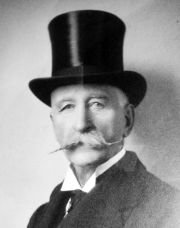Walter Claude Johnson
Walter Claude Johnson (1847-1928), partner in Johnson and Phillips and chairman of the D. P. Battery Co
1847 Born in Clapham, London[1] or in Sidmouth[2]
1859 Educated at Victoria College, Jersey[3]
1864-69 Apprentice at Vulcan Foundry, Newton-le-Willows under W. Gooch
1868 Matriculated in applied sciences at Kings College London
1869-70 Employed by Telegraph Construction Co in Bombay
1871 Chief engineer for the contractor laying cable in Java and Australia
1871-4 Designed machinery and superintended the outfitting of the SS Great Eastern and other vessels for laying the Atlantic Telegraph cable.
1875 Started business as telegraph engineer in partnership with Mr E. E. Phillips (sic) which became Johnson and Phillips. Established works at Charlton.
1875 Married Jane Fern in Lewisham[4]
Patented many improvements in telegraph apparatus
1881 Civil engineer, living in Eltham, with Jane Annie Johnson 30, Claude Johnson 4, Winifred Johnson 3[5]
1885 Joined Inst of Civil Engineers
1887 Walter C. Johnson, of Blackheath, was a member of the Inst of Electrical Engineers [6]
c.1888 Johnson and Bernard Mervyn Drake built and equipped works at Charlton for making storage batteries and formed the D. P. Battery Co., Ltd.
1891 Electrical engineer, born in Clapham, London, living at St John Common, Sussex, with Jane A Johnson 40, Valerie M C Johnson 1[7]
1901 Civil engineer, of Greenwich, with Jane A Johnson 50, Winnifred K Johnson 23, Valerie M Johnson 11[8]
1906 of Coleman's Hatch, Sussex[9]
1911 Civil engineer, employer, living in Coleman's Hatch, Forest row, Sussex with Jane Anne Johnson 60 and Claude Hornor Johnson, electrical engineer, 34[10]
1927 Final year in which he was recorded as belonging to the Inst of Electrical Engineers
1928 Died
1928 Obituary [11]
WALTER CLAUDE JOHNSON, who died on the 2nd June, 1928, in his 81st year, was born at Sidmouth, Devonshire, in 1847.
After being educated at Victoria College, Jersey, he became, in 1864, an articled pupil of the late Sir D. Gooch, then engineer-in-chief of the Great Western Railway, and later served a five years' apprenticeship at the Vulcan Foundry, Newton-le- Willows.
He then went to King's College, London, to study engineering construction and mechanical science.
In 1869 he joined the engineering staff of the Telegraph Construction and Maintenance Co. of East Greenwich, and was selected to superintend the conversion of the S.S. "Great Eastern" for cable laying. His services were also requisitioned for designing machinery for the laying, recovering and making of submarine cables, many of his inventions being adopted by the company. He was selected to accompany the laying of the first cable to India and was in charge of part of the cable-laying machinery.
On his return to England he planned the reconstruction of ships, and later proceeded with these to lay cables in Malaya and the Far East.
In 1875 he entered into partnership with Mr. Samuel Edmund Phillips, and the firm of Johnson and Phillips came into being. Their first workshop is still standing at Charlton.
Telegraphy was, in 1875 and for several years afterwards, practically the only commercial application of electricity, and the new firm's first business was the manufacture and sale of submarine telegraph-cable machinery and stores for cable steamers. In the design of the machines and gear by which the early cables were laid he had had to improvise, but with the founding of his firm he was able to give his attention to the scientific design of such machinery, drawing on his special technical knowledge and large experience, the result being that the bulk of the paying-out, picking-up, and cable-handling machinery of the world's cable fleet has been designed and made at Charlton.
After his partner died he was for 25 years, until the formation of the limited company, sole proprietor of the firm, and up to a few weeks before his death was chairman of the board.
When electric lighting began to be talked about he was quick to appreciate the possibilities of a new industry, and a department was formed at Charlton at an early date for the manufacture of alternators, dynamos, transformers, switchgear and all the usual electric-lighting accessories. The once well-known Brockie-Pell arc lamp was manufactured at Charlton by his firm.
From cable-laying machinery to cable-making machinery was perhaps a natural transition, and when the demand for insulated cables for electric lighting arose he equipped part of the Charlton works for the manufacture of cable-making machines. These were designed in the first instance for rubber covering, but, as time went on, machines for dealing with the heaviest classes of paper-insulated and armoured cables were constructed. He was actively interested in the formation of the Cable Makers' Association and its subsequent development.
In 1874 he built and equipped works at Charlton for making storage batteries and, with Mr. Bernard Drake, formed the D.P. Battery Co., Ltd., which built large works for the same purpose at Bakewell, Derbyshire. For 35 years he was chairman of this company.
He also took a large part in the formation of the present Tudor Accumulator Co.
He was of a somewhat retiring disposition, and never sought the publicity so often striven after by men of large fortune. A man of very liberal views, he was generous to a fault and those who came in contact with him will remember his kindly nature, the instances of his practical sympathy having been many. Apart from his business activities he took a great interest in matters artistic. Himself a painter of no mean order, in 1901 he founded the Connoisseur, a leading magazine of art known all over the world.
He was elected a Member of the Institution in 1875.


